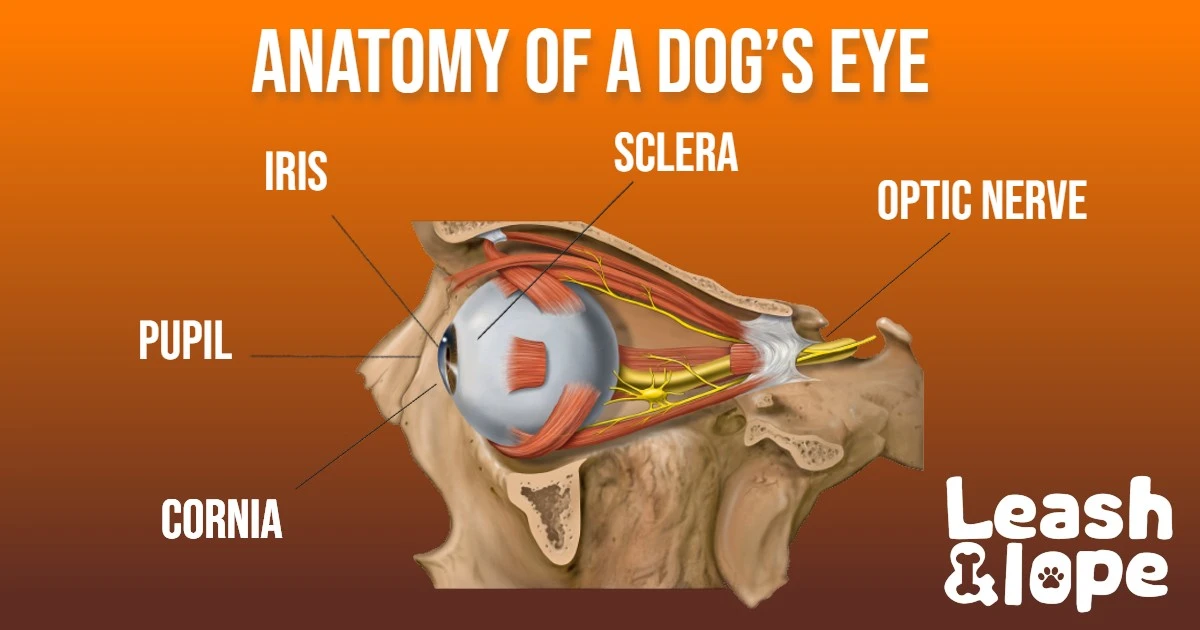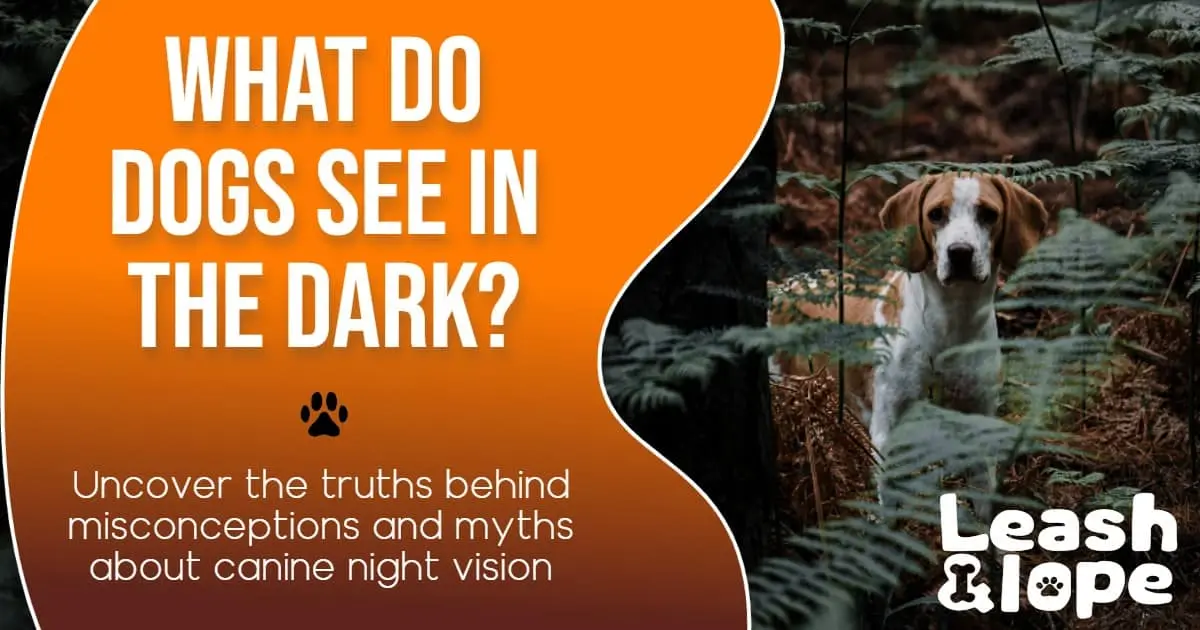Have you ever wondered what your dogs see in the dark when you’re out for a late-night stroll with them? When we are stumbling in a dark room, trying to avoid furniture, while our furry pet is moving around gracefully. It’s like they’ve got some superpower that helps them navigate around efficiently.
What’s the secret of their remarkable night vision?
From their exceptional night vision to their skill to detect movement in dim light conditions. Dogs have some extraordinary abilities when it comes to Seeing in The Dark.
Well, in this article, we’ll find out how dogs effortlessly do this by diving deep into the fascinating world of canine vision. We’ll shed some light on how our pups perceive their surroundings when the lights go out. It’s going to be a remarkable exploration into the eyes of our four-legged companions.
What Do Dogs See in The Dark? Compare to Humans

Dogs do have good vision in the dark, unlike humans. While they still need some degree of light to see. Their eyes are definitely more adapted to handle low-light situations than ours.
Although dogs cannot see in complete darkness, they can navigate and detect objects better than humans. This is because their eyes have more rod cells than ours, which helps them capture even a little bit of light.
A study published in the Journal of Comparative Physiology revealed that dogs possess a higher concentration of rod cells in their retinas compared to humans.
Additionally, the tapetum lucidum, a reflective layer behind their retina, increases their night vision by reflecting light back through their eyes.
Another study conducted at the University of California, Berkeley, revealed that the tapetum lucidum increases a dog’s sensitivity to light by approximately 40%.
Imagine you’re in a dark room, and it’s difficult for you to see anything clearly. But your dog would be able to perceive objects. It’s like having a night vision superpower that helps them explore their surroundings gracefully, even when it’s challenging for us to do.
Read More: How to Socialize Your Dogs with Other
Anatomy of a Dog’s Eye

Before we delve into finding the secret of their impressive night vision, let’s first familiarize ourselves with some basic aspects of the anatomy of a dog’s eye.
A dog’s eye consists of the following structures:
- Cornea
- Iris
- Pupil
- Lens
- Retina
- Tapetum Lucidum
Cornea
It’s a transparent membrane that protects the front of the eyeball. It allows the entry of light into the eye and is essential in focusing the light on the retina.
Iris
It’s a pigmented membrane, which consists of two muscles. It’s located between the cornea and the lens of the dog’s eye. The main function of this part is to control the size of the pupil during the regulation of the incoming light.
Pupil
It’s a dark opening located at the center of the iris. When the light is bright, the pupil constricts to limit the amount of light entering the eye. During low light conditions, the pupil dilates to allow more incoming light to enhance the dog’s vision.
Lens
It’s a transparent structure located just behind the iris. The light reaches the lens by passing through the pupil. The lens bends the rays of incoming light so that they are focused precisely onto the retina.
Retina
It’s a thin structure located at the back of the canine eye. It’s mainly responsible for converting light into electrical signals. These signals reach the brain through the optic nerve.
The retina consists of two main types of photoreceptors called Rods and Cones.
Rods are present in the peripheral part of the retina. They’re responsible for detecting motion and vision in dim light conditions. They also allow the dogs to have a wider view since they’re present on the edge of the retina.
Cones are present .in the central part of the retina. They’re responsible for detecting colors and allowing the dogs to have a detailed sight.
Tapetum Lucidum
Have you ever wondered why the eyes of your dog shine when light is directed into their eyes in the dark?
This is because of this reflective layer, called “Tapetum Lucidum”. It is located behind the retina. It’s like a superpower for our furry friends. It helps them see better in dim light conditions. It’s a shiny layer in a dog’s eye that acts like a mirror.
Its main function is to enhance their night vision. When light enters their eyes, this layer reflects it back onto the retina, giving them a second chance to capture more light and see better in the dark. It’s like having built-in night vision goggles. It’s an adaptation that helps dogs thrive in environments with limited light, such as forests or caves.
Is the Canine Field of View Wide in the Dark?

Yes, the field of view of dogs is wide in the dark. This is because of the special structures of the canine eye (Rod-dominated retina and tapetum lucidum).
However, the field of view is different in different breeds. For example, brachycephalic breeds have a greater field of view as compared to mesocephalic breeds.
The dogs belonging to the brachycephalic breed have short noses. Their eyes are also positioned more towards the side, increasing their field of view. It means that they can see more broadly. But, it reduces their depth perception.
Mesocephalic dogs have long noses. Their eyes are front-facing. They have a narrow field of view, however, it increases their binocular vision, hence increasing their depth perception as well.
An average dog is believed to have a visual field of approximately 240 degrees.
Can Dogs Perceive Depth Accurately in the Dark? (3D vision)
Depth perception allows dogs to accurately judge the distance and position of objects in their environment. It’s like having a 3D vision for our furry pals. It’s what helps them catch a ball mid-air. Dogs rely on various visual cues to perceive depth, such as binocular vision and motion parallax.
When the field view of both of the eyes overlaps, it results in binocular vision. Dogs have limited binocular vision as compared to humans because their eyes are located on the sides of their heads.
Motion parallax means the way objects appear to move at different speeds based on their distance from the observer. Dogs use this motion parallax to observe how far away an object is by observing its movement as it moves.
Because of limited light in visibly dark environments, these canine abilities are less effective during the dark and hence, dogs don’t rely on them solely in dim light conditions.
Are Dogs Color-Blind in the Dark?
No, dogs aren’t color-blind in the dark. However, they can’t perceive a wide range of colors in bright as well as low light conditions due to less number of cones
It’s a famous myth about dogs that they are completely color-blind. It’s not entirely true. While they might not be able to appreciate the vibrant hues of a rainbow-like we do, they can still distinguish between certain colors.
They can differentiate between blue-violet, yellow, and shades of gray. It’s kind of like watching an old-school black-and-white movie with a splash of those two colors. But hey, who needs all the fancy colors when you’ve got a loyal and loving furry friend by your side, right?
Can Dogs See Fine Details in the Dark?
The ability to see fine details is referred to as visual acuity. Dogs have less visual acuity as compared to humans in bright and dim light conditions.
Usually, they have a 20/75 vision. It means that an object which a human can see clearly at 75 feet, can be seen clearly by a dog at just 20 feet.
How Does Canine Vision Work at Night?
Since dogs have rod-dominant retinas, they can accurately detect movement and shapes in the dark. They also have a larger pupil which allows them to gather as much light as possible during low light conditions.
However, they’re not solely dependent on their vision in dim light.
Let’s not forget about their super-powered noses. Dogs rely majorly on their sense of smell, which helps them navigate and detect objects even when visibility is limited.
A study published in the journal Animal Behaviour suggested that dogs’ night vision plays a crucial role in their hunting and foraging behavior. The study observed that dogs rely more on their visual senses during low-light conditions to locate prey and navigate their surroundings. (Source: Animal Behaviour, 2017)
They can pick up on scents that are miles away and identify objects or creatures based on their smell alone. This is because they have around 300 million olfactory receptors while humans have around 5-6 million olfactory receptors.
Dogs have incredibly super-sensitive hearing that allows them to pick up even the faintest sounds.
These things serve them really well when it comes to hunting at night and protecting themselves from any potential danger.
Misconceptions and Myths About Dogs See in The Dark
Myth # 1: Dogs can see perfectly in total darkness
Fact:
While dogs have better night vision than humans. But, they can’t see in complete darkness. They rely on even small amounts of available light to see, thanks to their tapetum lucidum.
Myth # 2: Dogs See Everything in Black and White
Fact:
The reality is dogs don’t see the world in just black and white. They have some color vision, but it’s not as rich as humans. They see a limited range of colors, mostly in shades of blue and yellow.
Myth# 3: Dogs Can See in The Dark if They Have Glowing Eyes
Fact:
The glowing appearance in a dog’s eyes at night is due to the reflection of light by the tapetum lucidum. This reflection enhances their vision in low-light conditions but does not enable them to see in pitch-black darkness.
Myth# 4: Dogs Can See the Same Way During the Day & Night.
Fact:
Dogs have a specialized structure called the tapetum lucidum. It reflects light back into their eyes, enhancing night vision. However, this reflective layer can make their vision a bit blurry during the day.
In conclusion: What Dogs See in The Dark
Dogs have always been known for their incredible senses, and their vision is no exception. Understanding what dogs see in the dark and what dogs see at night sheds light on their remarkable visual abilities. And, discrimination and reveals a fascinating world of enhanced perception and adaptability.
It’s like they have their own secret night vision superpowers! Isn’t that paw-sitively amazing?
So next time you take your furry companion out for a nighttime stroll, remember that they are equipped with their own version of night vision goggles, ready to explore and experience the world in their own unique way. After reading this article, I hope you have a fair idea about what dogs see in the dark.

Dr. Haider is a general doctor with a unique level of connection to our four-legged friends. He is a valued contributor to our Website (Leash and Lope). Dedicated to providing accurate to dog owners in understanding and caring for their lovely pets.

